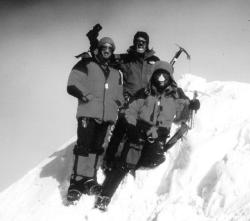|
Mount
McKinley
Denali:
"The Great One."
Climbing North America's
Icy Giant
by
Jim Garlinghouse
| "The
adventurer in each
of us yearns to
explore these icy
reaches, where we
seem to get a
broader perspective
on our own
minuteness and, at
the same time, our
own
significance."
Andy
Selters
|
......... |
 |
A
cold, biting wind whistled
down from the sharp-edged
mountains behind Ushuaia,
Argentina. Zipping my parka
against the cold and
leaning slightly into the
breeze, I made my way
toward a dilapidated phone
booth at the end of the
dock. Moored in its berth
was the Russian ship on
which I had spent the last
three months working as a
naturalist/polar historian,
cruising the continent of
Antarctica. We had arrived
earlier that morning. Now,
with time to kill, I
thought I’d make some
phone calls.
The
southernmost city in the
world located at the tip of
South America was in the
throes of a busy work day.
Noise and bustle filled the
air. A bag of cement being
loaded onto a freighter had
ruptured and spilled onto
the pier; there was also a
fight between a local cab
driver over a lost fare.
“Never a dull moment in
Ushuaia,” I thought as I
reached the phone booth. My
mind was still envisioning
icebergs, penguins and
leopard seals as I picked
up the phone.
“Hey,
Jim” said a voice on my
answering machine, “How
would you like to climb
Denali?” The voice
belonged to Dan White, a
friend with whom I had
previously climbed the
Wrangell-St. Elias
mountains in Alaska. He and
his brother Neil were
looking for a third to join
them. I still had two more
cruises to complete before
the Antarctic season ended,
but already, with this
teaser from Dan, my mind
was beginning to focus on
this great Alaskan peak.
Located
in the Alaska Range at a
height of 20,306 feet,
Mount McKinley, also known
as Denali, is a massive
peak of rock, snow and ice,
with extreme temperatures,
unpredictable weather, and
the greatest vertical rise
of any mountain on the
planet. Denali, meaning the
“Great One,” is also
considered one of the
coldest mountains; winter
temperatures of -60F have
been recorded. Simply put,
“The Great One” is one
of mountaineering premium
challenges.
The
optimum time to scale
Denali is between the
months of May and July with
nearly 24 hours of
daylight. Denali itself is
so high it creates its own
atmospheric conditions and
long periods of calm, clear
weather on the upper slopes
are rare. A combination of
skill, physical fitness and
common sense are a must on
any mountaineering
venture--but more so on
Denali. I was very pleased
to climb again with Dan and
Neil; both were strong,
enthusiastic climbers, and
all of us had various
ascents in Alaska and the
lower 48 to our credits. In
addition, both Neil and I
had previous ascents of
Denali, and I had the
privilege of exploring the
rarely-visited East
Buttress of the mountain in
1994 as a member of the
Ruth Glacier expedition
backed by the Frederick A.
Cook Society.
The
Antarctic season ended and
I returned home preparing
for “the Great One.”
Our plan was to arrive the
second week of June in
Talkeetna, a small town of
less than 500 souls located
120 miles north of
Anchorage. From there, we
would fly to the 7,200-foot
base camp and follow the
West Buttress route -- the
most popular and well
traveled route on the
mountain. From base camp
the route is roughly 16
miles and a climb of 13,000
vertical feet to the
wind-scoured summit.
On
June 16th the White
brothers and I arrived in
Talkeetna. A horde of
mosquitoes greeted us as we
made our way to Cliff
Hudson’s air hangar. It
was a blisteringly hot day,
but the peak itself was
wreathed in heavy cloud
cover---not a good sign.
The rule among the bush
pilots who routinely land
climbers at the 7,200-foot
base camp was “No sky, No
fly.” So as we stood
inside the spacious hangar,
waiting for the mountain to
clear, we stared at the
pile of gear on the cement
floor, and wondered how on
earth we would possibly get
all this stuff up the
mountain. When fully
loaded, our packs weighed a
good 60 pounds a piece.
This did not include the
20-30 pounds of food and
fuel we would be dragging
behind us on lightweight
plastic sleds.
Read
about previous Mount
McKinley/Denali topics.
Copyright
2005 - The Frederick A.
Cook Society
|